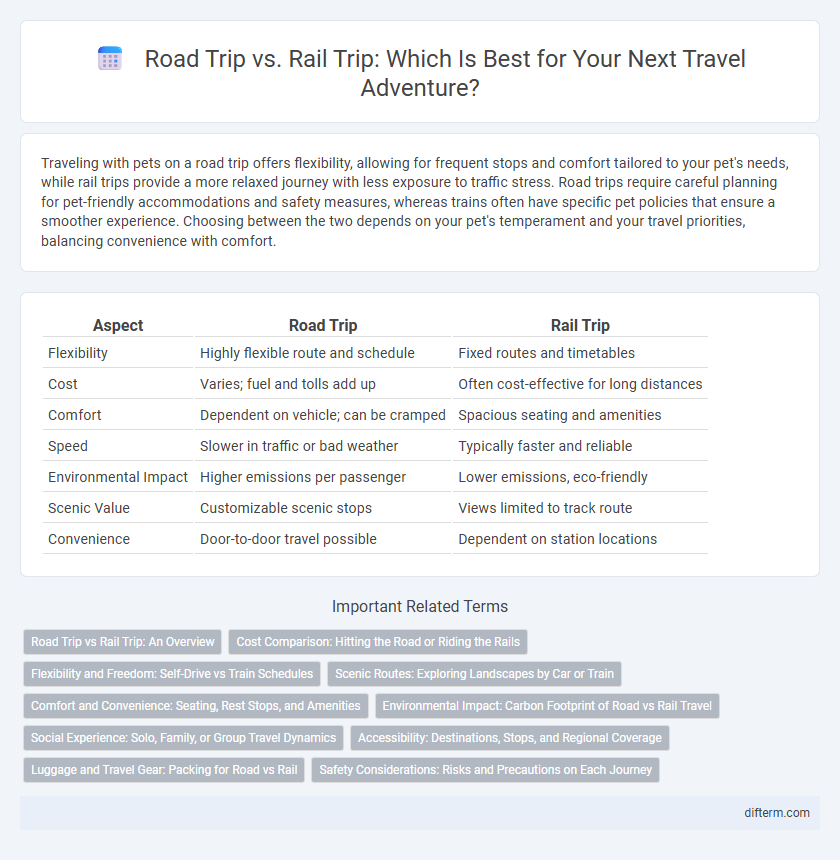Traveling with pets on a road trip offers flexibility, allowing for frequent stops and comfort tailored to your pet's needs, while rail trips provide a more relaxed journey with less exposure to traffic stress. Road trips require careful planning for pet-friendly accommodations and safety measures, whereas trains often have specific pet policies that ensure a smoother experience. Choosing between the two depends on your pet's temperament and your travel priorities, balancing convenience with comfort.
Table of Comparison
| Aspect | Road Trip | Rail Trip |
|---|---|---|
| Flexibility | Highly flexible route and schedule | Fixed routes and timetables |
| Cost | Varies; fuel and tolls add up | Often cost-effective for long distances |
| Comfort | Dependent on vehicle; can be cramped | Spacious seating and amenities |
| Speed | Slower in traffic or bad weather | Typically faster and reliable |
| Environmental Impact | Higher emissions per passenger | Lower emissions, eco-friendly |
| Scenic Value | Customizable scenic stops | Views limited to track route |
| Convenience | Door-to-door travel possible | Dependent on station locations |
Road Trip vs Rail Trip: An Overview
Road trips offer flexible routes and spontaneous stops, allowing travelers to explore remote destinations and scenic byways at their own pace. Rail trips provide a comfortable, eco-friendly alternative with amenities such as dining cars and sleeper cabins, connecting major cities efficiently. Choosing between road and rail depends on preferences for convenience, adventure, budget, and environmental impact.
Cost Comparison: Hitting the Road or Riding the Rails
Road trips often involve variable costs such as fuel, tolls, accommodation, and vehicle upkeep, which can fluctuate depending on distance and route. Rail trips generally provide predictable pricing through fixed ticket rates, with options for discounts, passes, and included amenities like meals or Wi-Fi. Evaluating total expenses requires analyzing factors like group size, travel duration, and flexibility, making rail travel potentially more cost-effective for solo travelers while road trips may offer savings for larger groups.
Flexibility and Freedom: Self-Drive vs Train Schedules
Road trips offer unparalleled flexibility, allowing travelers to set their own pace, explore off-the-beaten-path destinations, and make spontaneous stops without adhering to strict schedules. In contrast, rail trips operate on fixed timetables, which can limit freedom but provide a reliable and stress-free travel experience. For those prioritizing complete control over their itinerary, self-driving is the ideal choice, while train travel suits passengers seeking convenience and ease.
Scenic Routes: Exploring Landscapes by Car or Train
Scenic routes by car offer unparalleled flexibility to explore hidden landscapes, allowing travelers to stop at remote viewpoints and venture off the beaten path. Rail trips provide panoramic window views of vast, untouched wilderness and iconic landmarks, often coupled with comfortable amenities for a relaxed journey. Both modes grant access to breathtaking natural beauty, but the choice depends on the desire for personalized exploration or immersive, continuous scenery.
Comfort and Convenience: Seating, Rest Stops, and Amenities
Rail trips offer spacious seating with ample legroom and the freedom to move around, enhancing overall comfort compared to the typically confined space of car seats on road trips. Trains provide convenient rest stops at major stations with diverse dining options and onboard amenities such as restrooms, Wi-Fi, and dining cars, which reduce the need for frequent stops. Road trips allow flexible scheduling and personalized rest stops but often lack consistent access to amenities, impacting comfort during long drives.
Environmental Impact: Carbon Footprint of Road vs Rail Travel
Rail travel significantly reduces carbon emissions compared to road trips, with trains emitting approximately 41 grams of CO2 per passenger kilometer versus an average of 192 grams for cars. The energy efficiency of rail networks, particularly electric trains powered by renewable sources, contributes to this lower carbon footprint. As governments and travelers prioritize sustainability, choosing rail over road travel cuts greenhouse gas emissions, supporting global efforts to mitigate climate change.
Social Experience: Solo, Family, or Group Travel Dynamics
Road trips foster intimate social experiences by encouraging face-to-face interactions, making them ideal for families and groups seeking bonding time. Rail trips offer unique communal spaces such as dining cars and lounges that facilitate casual conversations, appealing to solo travelers and social groups alike. Both modes create dynamic social environments, but road trips provide customizable stops and privacy, while rail journeys emphasize shared experiences on a fixed route.
Accessibility: Destinations, Stops, and Regional Coverage
Road trips offer greater flexibility with accessibility to remote destinations and numerous stops along diverse routes, accommodating spontaneous detours and off-the-beaten-path experiences. Rail trips provide extensive regional coverage on established networks, connecting major cities and towns efficiently with comfort but limited accessibility to isolated areas. Travelers prioritizing comprehensive regional exploration and convenience may prefer rail, while those seeking customizable stops and access to less accessible locations often opt for road trips.
Luggage and Travel Gear: Packing for Road vs Rail
Road trips allow more flexibility in luggage size and travel gear, as vehicles can accommodate larger suitcases, coolers, and recreational equipment without strict weight or size limits. Rail trips often require compact, lightweight packing due to storage constraints and shared space, making soft bags and easily portable items more practical. Choosing between road and rail travel influences packing strategies significantly, balancing comfort against convenience and space limitations.
Safety Considerations: Risks and Precautions on Each Journey
Road trips involve higher risks such as car accidents, fatigue, and unpredictable weather conditions, necessitating precautions like regular breaks, seat belt use, and vehicle maintenance. Rail trips offer a safer environment with lower accident rates and professional crew oversight, but passengers should remain vigilant about platform safety and personal belongings. Both modes require awareness of emergency protocols and adherence to safety guidelines to ensure a secure travel experience.
Road trip vs Rail trip Infographic

 difterm.com
difterm.com